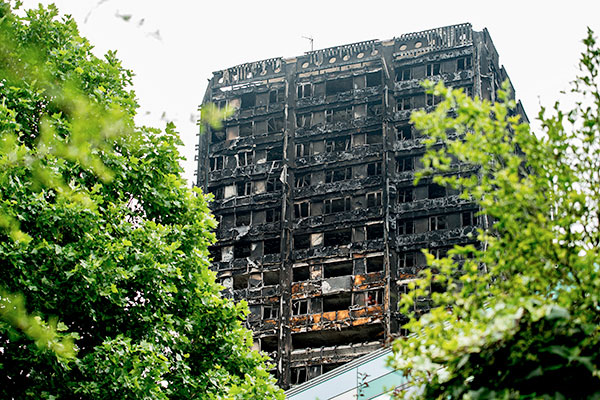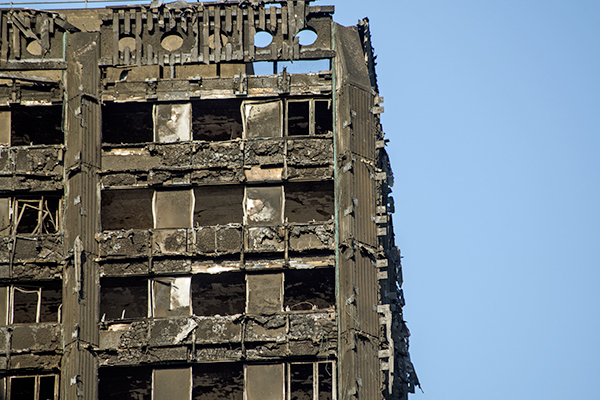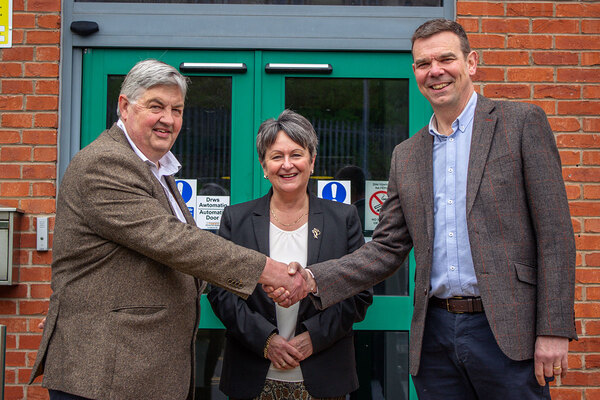You are viewing 1 of your 1 free articles
Insurance company to set up cheaper cladding fire safety test
An insurance company is designing a cheaper and quicker cladding test to discourage manufacturers from using building materials that have not been fire safety tested.
FM Global is planning to burn five-metre-high model walls instead of the nine-metre walls used for the current official large-scale test.
Currently, manufacturers wishing to use cladding materials not permitted by the government’s official fire safety guidance must use the nine-metre 8414 test or do a desktop study, which takes data from previous tests and extrapolates results for other cladding systems.
Manufacturers often say that the cost of doing the large-scale tests and the time they take are prohibitive, and mean they have to do desktop studies instead of testing every different cladding system.
Desktop studies, however, have been seen as controversial in the aftermath of the Grenfell Tower fire. No qualifications are needed for someone to do a desktop study and they have been used to declare some systems safe which later failed large-scale tests.
According to FM Global, a cheaper and quicker test would mean fewer manufacturers would use desktop studies.
Tom Roche, senior consultant of international codes and standards at the company, told Inside Housing: “We’re still confident that if we test something in this way, if it passed a nine-metre test, this apparatus would also demonstrate that it would successfully pass that test.
“When we do our testing, if we look at products that pass the 8414, when we do this test, we get similar results.”
FM Global will use the test as part of a certification it is developing for its insurance process, but it will not be an alternative method of meeting the requirements of building regulations.
One fire safety expert told Inside Housing: “It will only make sense if it’s representative of real world construction. If it is, I can see why it would be attractive to people and I can see why it might make desktop assessments less attractive as a shortcut.”
The government has said it is considering banning desktop studies, but a document submitted to the European Commission – seen by Inside Housing – that details its proposed changes to building regulations does not include a ban as an option.
What are desktop studies, and why are people concerned?
Building regulations say cladding systems which contain combustible insulation must be shown to meet specific standards based on “full scale test data”
A ‘desktop study’ is a means of making an assumption about whether or not a cladding system would meet these standards without actually testing it.
It involves using data from previous tests of the materials in different combinations to make assumptions about how it would perform in a test.
This is not specifically provided for in the current guide to building regulations, but the government believes they are loosely drafted to an extent which makes it permissible. It plans to redraft the guidance to include specific rules on the use of desktop studies for the first time.
The alternatives to a desktop study are full scale testing or not using combustible materials.
People are concerned about the process because it is based on assumption: at least one system cleared through a desktop study has failed a full scale test.
This is important for fire safety because mistakes may mean unsafe cladding systems being cleared for use on tall buildings.
The Paper Trail: The Failure of Building Regulations
Read our in-depth investigation into how building regulations have changed over time and how this may have contributed to the Grenfell Tower fire:
Never Again campaign
Inside Housing has launched a campaign to improve fire safety following the Grenfell Tower fire
Never Again: campaign asks
Inside Housing is calling for immediate action to implement the learning from the Lakanal House fire, and a commitment to act – without delay – on learning from the Grenfell Tower tragedy as it becomes available.
LANDLORDS
- Take immediate action to check cladding and external panels on tower blocks and take prompt, appropriate action to remedy any problems
- Update risk assessments using an appropriate, qualified expert.
- Commit to renewing assessments annually and after major repair or cladding work is carried out
- Review and update evacuation policies and ‘stay put’ advice in light of risk assessments, and communicate clearly to residents
GOVERNMENT
- Provide urgent advice on the installation and upkeep of external insulation
- Update and clarify building regulations immediately – with a commitment to update if additional learning emerges at a later date from the Grenfell inquiry
- Fund the retrofitting of sprinkler systems in all tower blocks across the UK (except where there are specific structural reasons not to do so)
We will submit evidence from our research to the Grenfell public inquiry.
The inquiry should look at why opportunities to implement learning that could have prevented the fire were missed, in order to ensure similar opportunities are acted on in the future.












